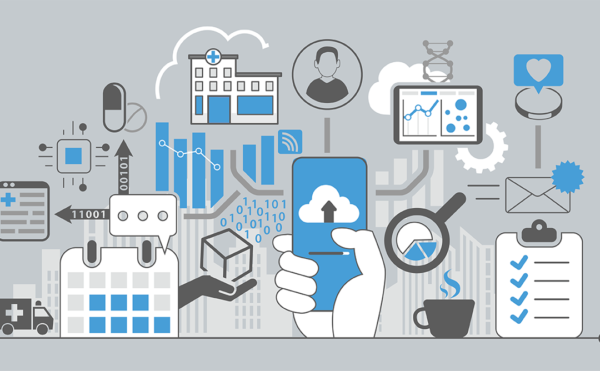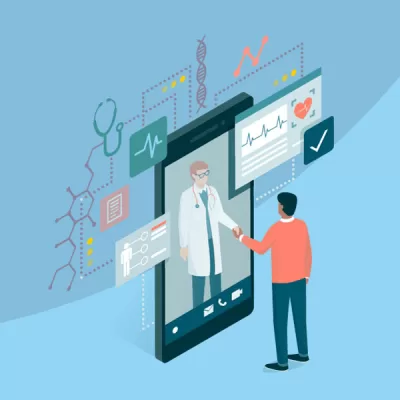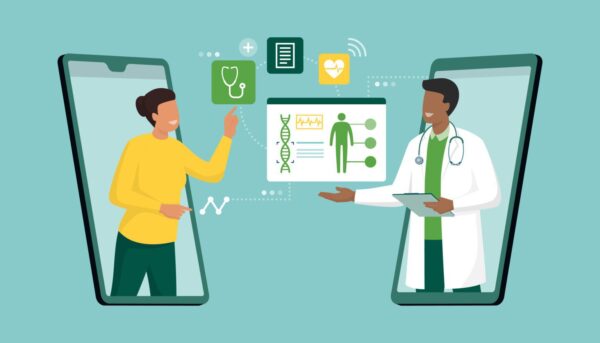As healthcare marketers, you understand the importance of staying up-to-date with the latest marketing trends in the industry. With the constantly evolving landscape of healthcare, it’s crucial to be proactive and adapt your strategy to the latest healthcare marketing trends accordingly. In this article, we will explore the current healthcare marketing trends that will shape the industry in 2024.
The best way to understand the healthcare marketing trends for 2024 is to outline current healthcare dynamics that will influence the trends. The core dynamics include an ageing population due to a longer-living generation, uncertainty in global economics, and continuous advancements in healthcare technology. The collective impact of all these dynamics means that the healthcare marketing space will see a significant transformation. As a marketer in this industry, you have to look out for the trends to stay ahead and earn a good return on investment for your efforts.

One of the biggest trends we’re seeing in healthcare marketing is the increased focus on digital channels. With the rise of telehealth and online healthcare services, it’s more important than ever to have a strong digital presence. From social media to search engine optimization, healthcare marketers are finding new and innovative ways to reach their target audience online.
Another trend that’s gaining traction in healthcare marketing is the use of personalized marketing. With the abundance of data available, healthcare marketers are able to create highly targeted campaigns that speak directly to the needs and interests of their audience. By using tools like email marketing and targeted advertising, healthcare marketers are able to deliver personalized messages that resonate with their audience on a deeper level.
It is also impossible to ignore the role of artificial intelligence (AI) in emerging healthcare marketing trends. AI provides data through predictive analytics and improves the efficiency of marketing strategies, such as using data to optimize content for enhanced website performance.
Digital Transformation in Healthcare
As the healthcare industry continues to evolve, digital transformation has become a key trend in healthcare marketing. We are witnessing a shift towards a more patient-centric healthcare system, where technology is being used to improve patient outcomes and experiences. In this section, we will explore some of the key digital transformation trends in healthcare.

Telehealth Expansion
Telehealth has been around for a while, but it has gained significant traction in recent years. With the COVID-19 pandemic, the adoption of telehealth has accelerated, and it is expected to continue to grow in popularity. We are seeing a rise in virtual consultations, remote monitoring, and other telehealth services. This trend is driven by the need for more accessible and convenient healthcare services, especially in rural areas.
Artificial Intelligence and Machine Learning
Artificial Intelligence (AI) and Machine Learning (ML) are transforming the healthcare industry, from drug discovery to patient care. AI and ML are being used to analyze large amounts of data, identify patterns, and make predictions. This technology is helping healthcare professionals make more informed decisions and improve patient outcomes. We are seeing AI and ML being used in areas such as personalized medicine, medical imaging, and drug development.
Virtual Reality in Patient Care
Virtual Reality (VR) is being used to enhance patient care and experiences. VR technology simulates medical procedures, provides pain relief, and improves patient education. This technology is particularly useful for patients with chronic pain or anxiety. VR is also being used to train healthcare professionals, allowing them to practice procedures in a safe and controlled environment.
Simply put, digital transformation is a key trend in healthcare marketing. Telehealth expansion, AI and ML, and VR are just a few examples of the ways technology is being used to improve patient outcomes and experiences. As technology continues to evolve, we can expect to see more innovative solutions that will transform the healthcare industry.
1. Patient-Centric Marketing

As healthcare marketers, we must focus on the patient’s needs and preferences to provide an exceptional experience. Patient-centric marketing is a strategy that puts the patient’s needs at the center of all marketing efforts. In this section, we will discuss the key components of patient-centric marketing.
Personalized Patient Experience
Personalization is a critical component of patient-centric marketing. Patients expect a personalized experience that caters to their unique needs and preferences. Healthcare organizations must use patient data to create personalized experiences that engage patients and improve outcomes. Personalization can be achieved through various channels, including email marketing, social media, and mobile apps.
Healthcare CRM Systems
Healthcare Customer Relationship Management (CRM) systems are essential tools for patient-centric marketing. These systems allow healthcare organizations to manage patient data, track patient interactions, and create personalized experiences. Healthcare CRM systems provide valuable insights that can be used to create targeted marketing campaigns and improve patient outcomes.

Content Marketing
Content marketing is a powerful tool for patient-centric marketing. Healthcare organizations can create valuable content that educates and informs patients about their health and wellness. Content marketing can be used to create a relationship with patients that goes beyond the clinical encounter. Patients appreciate organizations that provide valuable information that helps them make informed decisions about their health.
In conclusion, patient-centric marketing is a critical strategy for healthcare organizations to improve patient outcomes and create a positive patient experience. Personalization, healthcare CRM systems, and content marketing are key components of patient-centric marketing that can help organizations achieve their goals. By focusing on the patient’s needs and preferences, healthcare organizations can create a relationship with patients that goes beyond the clinical encounter.
2. Data-Driven Healthcare Marketing
At the forefront of healthcare marketing trends is the use of data-driven strategies. By leveraging data, healthcare organizations can better understand their patients and make informed decisions about their marketing efforts. In this section, we will explore some of the ways data is being used in healthcare marketing.
Predictive Analytics
Predictive analytics is a powerful tool for healthcare marketers. By improving efficiency in analyzing patient data, marketers can predict which patients are most likely to need certain services or procedures. This allows marketers to target their efforts more effectively and ensure that patients receive the care they need.

Big Data in Healthcare
The use of big data in healthcare has exploded in recent years. With the vast amount of data available, healthcare organizations can gain insights into patient behavior, preferences, and needs. By leveraging this data, marketers can create more personalized and targeted campaigns that resonate with patients.
Marketing Automation
Marketing automation is another trend that is gaining traction in healthcare marketing. By automating certain marketing tasks, such as email campaigns or social media posts, healthcare organizations can save time and resources while still reaching their target audience. Additionally, automation allows for more personalized and timely communication with patients.
In the wake of drastic technological advancements, data-driven healthcare marketing is a trend that is here to stay. By leveraging data and technology, healthcare organizations can create more effective campaigns that resonate with patients and drive results.
3. Social Media and Influencer Marketing
We believe that social media and influencer marketing will continue to be a significant trend in healthcare marketing. With the majority of people using social media platforms, it is an excellent opportunity for healthcare organizations to reach a broad audience and engage with patients and consumers.

Healthcare Influencers
One way to leverage social media is by partnering with healthcare influencers. These individuals have a significant following on social media platforms and can help promote healthcare products and services to their audience. Healthcare influencers can include doctors, nurses, patient advocates, and other healthcare professionals.
Partnering with healthcare influencers can help increase brand awareness, improve credibility, and drive engagement. However, it is crucial to ensure that the influencer aligns with the organization’s values and mission and follows ethical guidelines.
Social Media Advertising
Another way to leverage social media is through advertising. Social media platforms offer a variety of advertising options, including sponsored posts, promoted tweets, and social media ads.
Social media advertising can help healthcare organizations reach a specific target audience, increase website traffic, and generate leads. However, it is essential to ensure that the advertising complies with applicable laws and regulations and follows ethical guidelines.
In conclusion, social media and influencer marketing are significant trends in healthcare marketing. By leveraging these strategies, healthcare organizations can reach a broad audience, engage with patients and consumers, and improve brand awareness and credibility.
4. New Technologies and Healthcare Marketing

As the healthcare industry continues to evolve, so do the marketing strategies that healthcare providers use to reach their target audience. In this section, we will explore two future trends in healthcare marketing that we believe will become increasingly important in the coming years.
Voice Search Optimization
Voice search is quickly becoming a popular way for people to search for information online. As more and more people use voice search to find healthcare providers and services, it’s important for healthcare marketers to optimize their content for voice search.
To optimize for voice search, we recommend the following strategies:
- Use natural language in your content
- Answer common questions your target audience may ask
- Use structured data to help search engines better understand your content
- Ensure your website is mobile-friendly
By optimizing for voice search, healthcare providers can improve their visibility in search results and better connect with their target audience.
Chatbots and Virtual Assistants
Chatbots and virtual assistants are becoming increasingly popular in healthcare. These tools can help healthcare providers provide better customer service and support, while also improving patient engagement.
Some ways that healthcare providers can use chatbots and virtual assistants include:
- Answering common patient questions
- Scheduling appointments
- Providing medication reminders
- Offering personalized health advice

By using chatbots and virtual assistants, healthcare providers can improve patient satisfaction and engagement, while also freeing up staff time to focus on more complex tasks.
In conclusion, voice search optimization and chatbots/virtual assistants are two future trends in healthcare marketing that we believe will become increasingly important in the coming years. By staying up-to-date with these trends and incorporating them into their marketing strategies, healthcare providers can better connect with their target audience and improve patient satisfaction and engagement.
overall, the healthcare marketing trends to look out for in 2024 mainly revolve around the technological advancements taking place, including social media and influencer marketing, which is the result of increased internet use. As a healthcare marketer, you should take these dynamics into consideration to stay ahead of competitors while also earning a good return on investment for your efforts.
